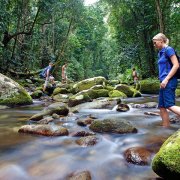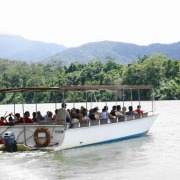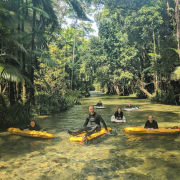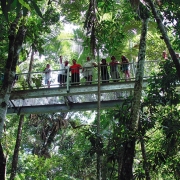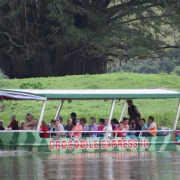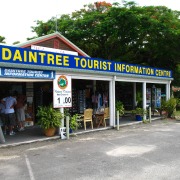5 Tours Found
We found 5 tours in the Guided Walks category
Wildlife
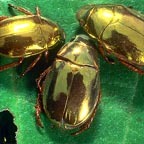
The Wet Tropics World Heritage Region contains Australia’s greatest diversity of animals and plants within an area of just 0.26% of the continent. It is home to: 26% of Australia's frogs, 17% of it's reptiles, 58% of it's butterflies, 30% of marsupial species and 48% of it's birds, many of which are endemic to this eco system only. Most of the world's 19 primitive plant families are found in Daintree National Park and the surrounding area.A visit to the Daintree is a magical experience where you can view some of the most ancient, rare, primitive and endemic species in all thier natural glory.
Cooper Creek Wilderness
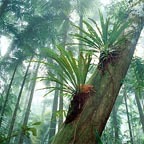
Situated directly below Wundungu (Thornton Peak), midway between the Daintree River and Cape Tribulation; Cooper Creek Wilderness presents a living museum that contains every stage in the evolution of plants and animals. This last remnant of the oldest-surviving rainforest in the world has survived more than 170-million years, containing the most extensive populations of primitive angiosperms (flowering plant families) in the world. A specialist guided rainforest tour will introduce you to grandeur and awe-inspiring beauty of this ancient rainforest. Treks are on the rainforest floor, unspoiled by artificial structures. You will be guided through this complex rainforest environment, gaining entry to the primitive sections of the Daintree Rainforest that are off the beaten track and that very few get to see.
Find out more:
Cooper Creek Wilderness - Guided Interpretive Walks
Daintree Nocturnal Walks
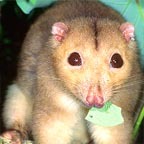
The greatest opportunity to observe some of Australia’s most unique wildlife in natural habitat occurs after nightfall. Temperature, rainfall and moonlight all have profound effects on wildlife behaviour; the most ideal conditions occur on the hottest, wettest and darkest nights. With an experienced guide who knows what signs to look for, you will have the opportunity to meet some of the animals living in the forest. In addition to frequent sightings of sleeping birds and rainforest dragons, the nocturnal tours regularly encounter forest mammals including bats and possums, many species of spiders and insects plus beautiful snakes including amethystine and carpet pythons and brown tree snakes. Of the five ringtail possum species found in North Queensland rainforests, the Daintree River ringtail possum Pseudochirulus cinereus is almost wholly restricted to the Daintree catchment. In the park this species is found only in upland rainforest on Thornton Peak and the upper reaches of the Daintree and Mossman rivers. Ringtail possums are mostly nocturnal, spending the day resting in tree hollows and epiphytic clumps.
Find out more:
Cooper Creek Wilderness - Guided Noctural Walk
Jungle Adventures 2 Hour Nightwalk
Daintree River Cruises
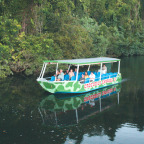
The Daintree River contains 31 mangrove species, with the surrounding mangrove forests attracting rare and locally prolific bird life, plants, frogs and insect species. The best way of seeing and understanding the river's ecosystem and wildlife is to take a Daintree River Cruise. Crocodile Express cruises from the picturesque Daintree Village and covers a diverse section of the river in a mix of fresh and salt-water ecosystems. Journey through narrow creeks with an enthusiastic team of local river guides who will provide an interactive and entertaining experience spotting a variety of wildlife in their natural surrounds. Daintree River Experience offers a small personalised tour for just 8-10 passengers. Morning and evening departures are timed to coincide with peak bird activity and to give the photographers the best light. Their modern boat is specifically designed to give greater stability for the keen photography enthusiast. This area is also the habitat of the estuarine or saltwater crocodile seen regularly on river cruises, also look out for other reptiles, rare birds, flying foxes and beautiful butterflies.
Find out more:
Crocodile Express
Daintree River Experience
Jungle Surfing
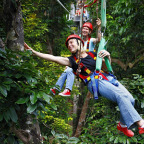
Jungle Surfing Canopy Tours is a fun adventure activity for all the family. This unique rainforest tour will take you to new heights where your feet don’t touch the ground! With its low-impact system of platforms and cables, Jungle Surfing offers unparalleled access to the heart of the Daintree from the bustling forest floor to the giants that tower above the canopy. Fly through the trees on flying fox ziplines, stopping at 5 tree platforms to take in spectacular bird’s eye views over the treetops, down to cascading streams and out to the Great Barrier Reef. Jungle Surfing is a unique activity where the guides control your
flight so no prior experience or specific fitness is required.
Find out more:
Jungle Surfing Canopy Tours
Croc Facts
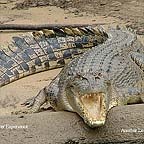
- The Daintree River has a population of about 70 adult crocodiles, the largest being the males at about 5 metres. Females reach about 3.5 metres.
- Australia has two species of crocodiles. Despite their names both esturine (saltwater) and freshwater crocodiles can live in fresh and salty water, but 'freshies' tolerate only brackish (slightly salty) water.
- Esturine crocodiles occupy tidal and non-tidal rivers, swamps and billabongs in the north of Australia. Their range can extend quite some distance inland; they have been found about 68 kilomteres up the Daintree River.
- In wintry weather these reptiles climb ashore more frequently and stay out longer to bask in the sun. They usually re-enter the water after dark because during the night the water is warmer than the air.
Birdwatching
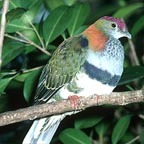
The Daintree National Park is internationally recognised as one of Australia's premier birdwatching locations. Over 430 species of birds have been recorded in the area encompassing the Wet Tropics and the Great Barrier Reef region of Australia. This is more than half the bird species for the entire continent. Whatever time of year you decide to visit there will always be plenty of birds to see. With lowland rainforest, wetlands, riverine, mangrove, grassland and urban habitats, the diversity of birdlife is immense. Sought-after species include Double-eyed Fig-Parrot, Little Bronze-Cuckoo, Wompoo Fruit-Dove, Buff-breasted Paradise Kingfisher, Beach Stone-Curlew, Lovely Fairy-Wren and Yellow Oriole.
Red Mill House has been well known as a popular birdwatching destination for many years. Owned and operated by Andrew and Trish Forsyth, two enthusiastic birders, they will happily provide you with good up-to-date information and advice. The extensive gardens of Red Mill House are renowned for Daintree birdlife. With a large natural pond and many fruiting and flowering rainforest and exotic trees, the garden creates a haven for many bird species, including Little Kingfisher, Wompoo Fruit-Dove and many more. Reptiles, frogs and butterflies abound in the garden and some mammals such as Spectacled Flying-Fox and Northern Brown Bandicoot are regular visitors. Red Mill House is located in the Daintree Village; this traditional B&B has a strong focus on nature and the wildlife of the Daintree.
Find out more:
Red Mill House B&B
The Southern Cassowary
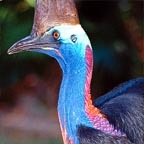
One of the iconic species of the Daintree is the endangered Cassowary. This large, flightless bird is the largest native vertebrate in Australian rainforests. Adults can stand up to 2 m tall, with males weighing up to 55 kg and females up to 76 kg. They can often
be seen strolling along McLean’s Creek in search of food. Cassowaries play a significant role in the dispersal of rainforest fruit. Cassowaries are the only native animals large enough to eat many of the larger fleshy rainforest fruits with large seeds. The seed remains in the cassowary's gut for approximately 10 hours, ensuring they are deposited some distance away from the parent tree. Once the fruit has passed through the bird most of the fleshy part of the fruit has been removed from the seed leaving it ready to germinate in a lovely pile of compost. Cassowaries are endangered so to see one in the wild is an absolute highlight for most birdwatchers.
Find out more:
Daintree Discovery Centre




